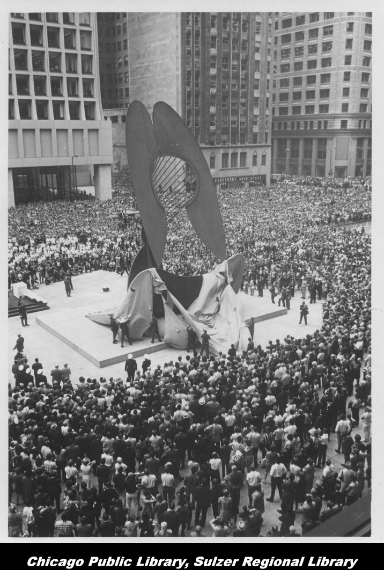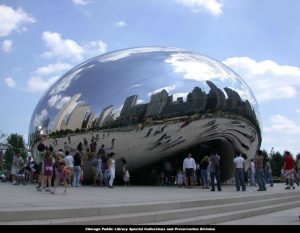In the early 1960s, the architectural firm Skidmore, Owings & Merrill was working on designs for Daley Plaza. Architect William Hartmann helped convince Spanish artist Pablo Picasso to design a sculpture for the space. Picasso would not accept payment, making this artwork a gift to the people of Chicago.
Constructed from the same Cor-Ten steel used in the surrounding buildings, the Chicago Picasso was fabricated in Gary, Ind., at the U.S. Steel plant. It was then transported to Daley Plaza and assembled.
On August 15, 1967, the sculpture was unveiled to a crowd of thousands of people. Poet Gwendolyn Brooks composed and delivered a poem especially for the occasion. The opening lines capture some of the conflicted feelings over this statue:
Does man love Art? Man visits Art, but squirms.
Art hurts. Art urges voyages—
and it is easier to stay at home...
Public art in most big cities up to that point had primarily taken the form of classical sculpture or statues of historical figures. Many Chicagoans found the Picasso statue's abstract style controversial. Picasso did not give the sculpture a title or explain what it represented, and no one can agree on what it is. Interpretations include a horse, an Afghan hound, a woman, the Egyptian god Anubis, among others.
2017 is the Year of Public Art in Chicago. The Picasso statue's 50th anniversary is getting special attention with several public events including a re-staging of the dedication on August 8, a panel discussion on August 15 and an author talk at CPL on August 15.
You can view images from the dedication of the Picasso statue in the Robert W. Krueger Photograph Collection in CPL's Northside Neighborhood History Collection.
Learn more about the history of public art in Chicago at CPL's Special Collections. The Madeline Murphy Rabb Papers document the work of the executive director of the Chicago Office of Fine Arts under Mayor Harold Washington. The collection covers programs like Percent for Art, which requires new public buildings to set aside 1.33 percent of their budgets for public art installations on site.
The Chicago Park District Drawings and Chicago Park District Photographs document the placement of statuary and art in Chicago's vast park system.
Over its 50 years, the Picasso statue has become one of the symbols of Chicago. Some of the city's newer symbols, including Crown Fountain and Cloud Gate (the Bean), are found in Millennium Park. You can learn about the development, design and construction of Millennium Park and its art in the Millennium Park, Inc. collection, the Millennium Park, U.S. Equities Realty Collection and the Millennium Park Digital Collection.
The Harold Washington Library Center also boasts its own impressive collection of public art. You can learn more at our art tours.
What is your favorite public artwork in the city?





Add a comment to: Happy 50th to the Chicago Picasso!